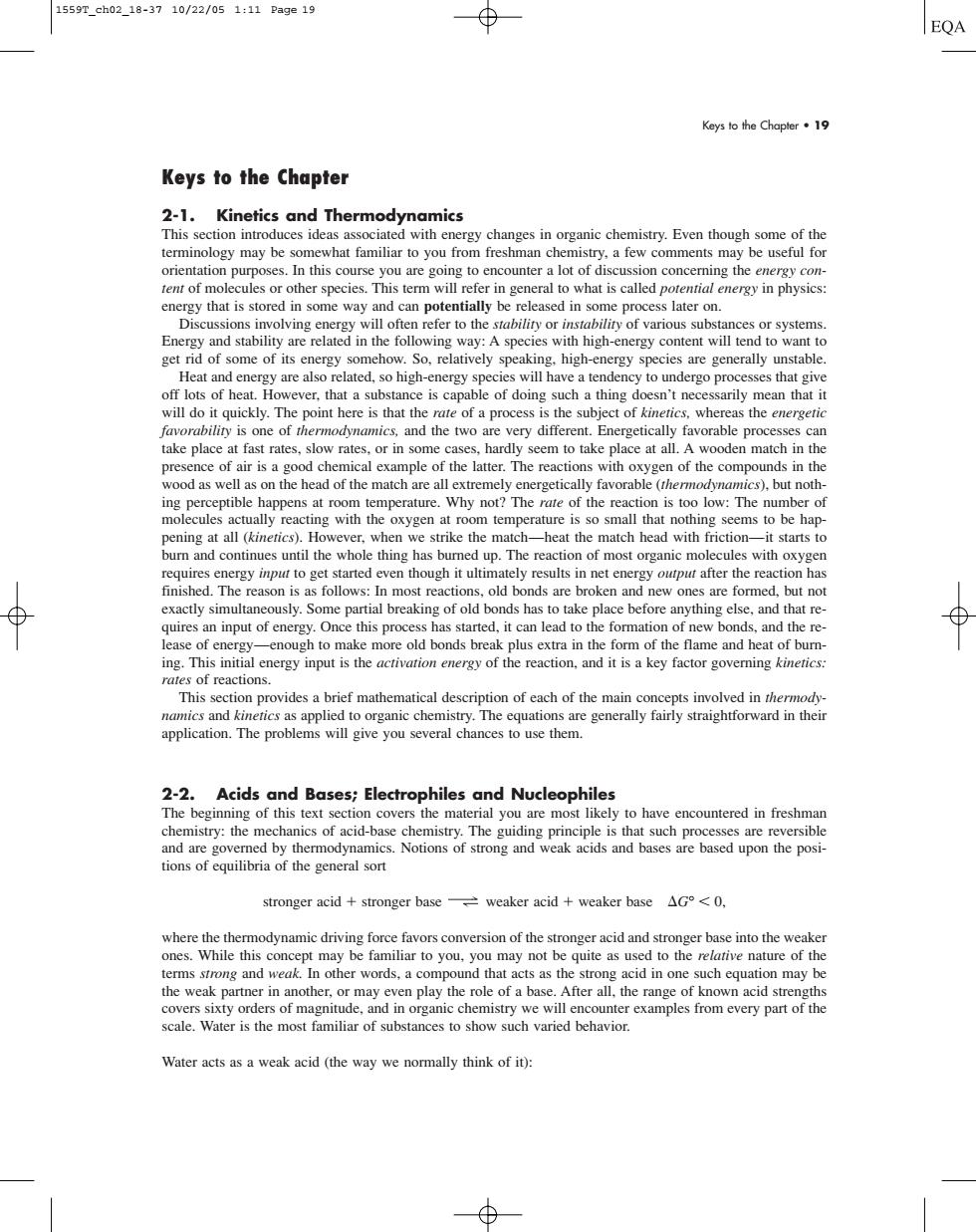正在加载图片...

1559T_ch02_18-3710/22/051:11Page19 ⊕ EQA Keys to the Chapler·19 Keys to the Chapter amics changes in or nic chemistry.Even though some of the orientation purpose this co conc s later on get rid of some of its energy somehow.So.relatively speaking.high-energy species are generally unstable. Heat and also related,so high-energy species will hav a tendency to undergo processes that give and the two are very different.Energetically favorable processes can take placc at st rate or in some vooden match in th happens at ro om temperature.Why Thee of the s:The umber 0 bum and continues until the whole thing has bumed up.The reaction of most organic molecules with oxyger ven tho gn n ui net en rgy anter the rea on ha Some partial breaking of old bonds has to take place before anything else,and that re quires an input of ener gy.Onc this proc rted,it can leac ew bo s.and the re of reactions ides nlied apiction.The problemsillive youhances tousethm. Acids and Bases;Electrophiles and Nucleophiles and are govemed by the ions of equilibria of the general sort stronger acid+stronger base=weaker acid+weaker base△G°<0, terms strong and weak.In other words,a compound that acts as the strong acid in one such equation may be scale.Water is the most familiar of substances to show such varied behavior. Water acts as a weak acid (the way we normally think of it): Keys to the Chapter • 19 Keys to the Chapter 2-1. Kinetics and Thermodynamics This section introduces ideas associated with energy changes in organic chemistry. Even though some of the terminology may be somewhat familiar to you from freshman chemistry, a few comments may be useful for orientation purposes. In this course you are going to encounter a lot of discussion concerning the energy content of molecules or other species. This term will refer in general to what is called potential energy in physics: energy that is stored in some way and can potentially be released in some process later on. Discussions involving energy will often refer to the stability or instability of various substances or systems. Energy and stability are related in the following way: A species with high-energy content will tend to want to get rid of some of its energy somehow. So, relatively speaking, high-energy species are generally unstable. Heat and energy are also related, so high-energy species will have a tendency to undergo processes that give off lots of heat. However, that a substance is capable of doing such a thing doesn’t necessarily mean that it will do it quickly. The point here is that the rate of a process is the subject of kinetics, whereas the energetic favorability is one of thermodynamics, and the two are very different. Energetically favorable processes can take place at fast rates, slow rates, or in some cases, hardly seem to take place at all. A wooden match in the presence of air is a good chemical example of the latter. The reactions with oxygen of the compounds in the wood as well as on the head of the match are all extremely energetically favorable (thermodynamics), but nothing perceptible happens at room temperature. Why not? The rate of the reaction is too low: The number of molecules actually reacting with the oxygen at room temperature is so small that nothing seems to be happening at all (kinetics). However, when we strike the match—heat the match head with friction—it starts to burn and continues until the whole thing has burned up. The reaction of most organic molecules with oxygen requires energy input to get started even though it ultimately results in net energy output after the reaction has finished. The reason is as follows: In most reactions, old bonds are broken and new ones are formed, but not exactly simultaneously. Some partial breaking of old bonds has to take place before anything else, and that requires an input of energy. Once this process has started, it can lead to the formation of new bonds, and the release of energy—enough to make more old bonds break plus extra in the form of the flame and heat of burning. This initial energy input is the activation energy of the reaction, and it is a key factor governing kinetics: rates of reactions. This section provides a brief mathematical description of each of the main concepts involved in thermodynamics and kinetics as applied to organic chemistry. The equations are generally fairly straightforward in their application. The problems will give you several chances to use them. 2-2. Acids and Bases; Electrophiles and Nucleophiles The beginning of this text section covers the material you are most likely to have encountered in freshman chemistry: the mechanics of acid-base chemistry. The guiding principle is that such processes are reversible and are governed by thermodynamics. Notions of strong and weak acids and bases are based upon the positions of equilibria of the general sort stronger acid stronger base weaker acid weaker base G° 0, where the thermodynamic driving force favors conversion of the stronger acid and stronger base into the weaker ones. While this concept may be familiar to you, you may not be quite as used to the relative nature of the terms strong and weak. In other words, a compound that acts as the strong acid in one such equation may be the weak partner in another, or may even play the role of a base. After all, the range of known acid strengths covers sixty orders of magnitude, and in organic chemistry we will encounter examples from every part of the scale. Water is the most familiar of substances to show such varied behavior. Water acts as a weak acid (the way we normally think of it): 1559T_ch02_18-37 10/22/05 1:11 Page 19��